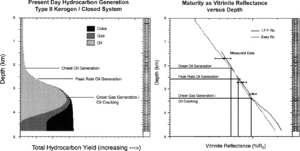Kerogen type and maturity
Revision as of 21:10, 15 July 2014 by FWhitehurst (talk | contribs)
| Exploring for Oil and Gas Traps | |

| |
| Series | Treatise in Petroleum Geology |
|---|---|
| Part | Critical elements of the petroleum system |
| Chapter | Evaluating source rocks |
| Author | Carol A. Law |
| Link | Web page |
| Store | AAPG Store |
Each kerogen type has its own relationship to maturity parameters. Maturity measurements are made on materials other than kerogen; therefore, they are not a direct measure of the hydrocarbon generation stage of the source intervals. A relationship must be established between maturity of the geologic section and hydrocarbon generation for each kerogen type in a basin. This relationship can be derived using 1-D basin modeling techniques.
Hydrocarbon generation and maturity
The hydrocarbon generation-depth curve in Figure 1 indicates where various phases of hydrocarbons would be generated today in the geologic section if a uniform kerogen existed throughout. We would use the following steps to compare the relationships.
| Step | Action |
|---|---|
| 1 | Define the hydrocarbon generation stage for a calibrated well based on the depth vs. hydrocarbon yield plot (left figure). For example, the onset of oil generation occurs at approximately length::2.1 km. Then transfer to the depth versus maturity plot (in this case vitrinite reflectance, right figure) and follow across at length::2.1 km until you reach the maturity profile. This vitrinite reflectance value (0.55 %Ro ) would indicate the onset of hydrocarbon generation in this well. |
| 2 | Apply this relationship to predict the generation zones for this specific kerogen in wells with similar thermal and burial histories in the basin for which maturity data are available. |
See also
- Relationships between maturity and hydrocarbon generation
- Kerogen type and hydrocarbon generation
- Kerogen type and transformation ratio
- Kerogen types: comparison of maturity measures
- Open- vs closed-system generation modeling
